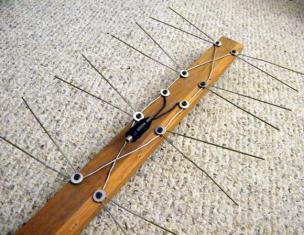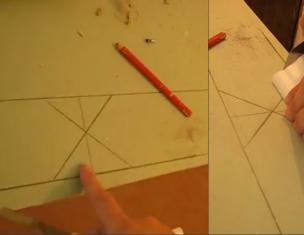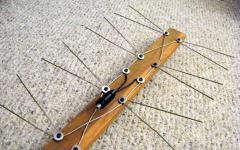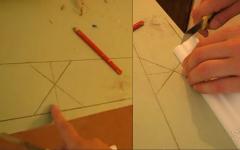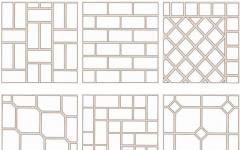It is difficult to imagine construction and renovation work that did not use drywall. Internal partitions, boxes for water and sewer pipes, multilevel ceilings, arches, decorative elements in the interior are made of it. Plasterboard sheets align the walls, significant floor defects.
Smooth, broken, rounded plasterboard structures should be putty before painting or wallpapering. How to properly putty drywall, not being a master of finishing, we will cover in this article.
Instruments
For independent work you will need:
- foam rollers and priming brushes,
- stainless steel spatulas 10, 20 and 40-50 cm wide,
- containers for the mixture and for water,
- sanding float with fasteners for mesh or paper,
- sandpaper or sanding net,
- mixer-attachment for a drill,
- construction knife
- rule length 1.5-2.0 m
- respirator, goggles, rubber gloves.
Materials for work
- deep penetration soil,
- putty,
- serpyanka or perforated paper tape for seams,
- perforated metal and plastic corners,
- fiberglass,
- glue for fiberglass.
Putty

Every novice finisher has a question, what is the best way to putty drywall. For work, use a rough and finishing plaster, cement or polymer putty. There are dry mixes and ready-made solutions on sale.
Attention ! Following the principle: "like connects with like", it is preferable to apply gypsum plaster on drywall.
For finishing rooms with high humidity, cement, lime compounds or polymer putty are suitable.
For the main finishing, craftsmen use Fugenfüller gypsum putty or cement Hercules, for the top layer - finishing polymer Bergauf or Ceresit.
Surface preparation
The quality of the finish depends on how well the drywall is prepared for applying a layer of putty. To do this, you should:

Padding
The purpose of applying the primer is to create a polymer film that prevents moisture penetration into the depths and possible peeling of the drywall paper coating, as well as increase the adhesion of the putty to the base.


Anyone can use deep penetration primer, but professionals recommend Ceresit CT17 primer. It creates a durable film. It is recommended to apply it in 2-3 layers, each next one is applied after the previous one has completely dried.
Preparation of the solution

Gypsum putty is very demanding on the cleanliness of the container in which the mixture is prepared, and it sets quickly enough. The solution should be prepared for 0.5-1 hour of work according to the instructions on the package.
Pouring dry powder into water, add it until dry islands appear on the surface. This indicates that the proportions are met. Stir the mixture quickly until it is homogeneous and free from lumps and leave for 5 minutes. The putty should be of the thickness of sour cream. After that, stir again and you can start working.
Attention ! It is not recommended to stir the plaster putty solution after preparation.
Preparation of corners and joints
Plastering drywall begins with the preparation of corners and joints. Here you need a narrow spatula and a small amount of mortar.
What kind of putty to putty drywall seams? To do this, use the composition of Knauf Fugen. The embroidered seams are filled with a mixture, then strips of special self-adhesive mesh or perforated paper are glued and smoothed with a spatula. The mesh is 5-10 cm wide for a firm grip.


After the putty has completely dried, you need to check if the threads of the reinforcing mesh are sticking out, remove them with a knife, carefully cut off the irregularities of the filling with a spatula and prime everything.
Puttying
Plasterboard on ceilings and walls is done differently depending on the type of finish. If you plan to stick wallpaper, the main and finishing layer of putty will be enough. For finishing for painting and Venetian plaster, you will need fiberglass.
How to putty the ceiling

The ceiling can be putty immediately with finishing putty in 1-2 layers. Work is carried out from any wall with good lighting.
Important ! If you plan to apply two layers, then they should be applied perpendicular to each other, so that the latter is from the window along.
This is done as follows:
A small amount of mortar is placed on a wide spatula and it is applied to the surface with wide movements from the wall towards or away from yourself. After a sufficient area has been processed, the layer is finally leveled with a rule moistened with water. Craftsmen do not use the rule, but it will come in handy for a novice finisher. This is how the entire surface is treated.

If dark spots of drywall do not appear from under the layer of dried putty, this can be limited. If the layer is uneven, you need to apply a second one. For this, irregularities are removed with a sanding mesh, the ceiling is primed and putty again. The dried surface is carefully sanded, dust is removed and primer is applied to it for painting.
How to putty drywall under the wallpaper
To make it clear how to properly putty drywall, a video from experienced craftsmen will help you understand all the subtleties.
You will need a narrow and wide spatula. In order for the putty to be of high quality, consider a few subtleties:
- the spatula should not have bent corners, notches and other defects on the working surface;
- in the process of work, you need to ensure that lumps of dried solution and other solid particles do not get into the solution and onto the spatula. They will leave stripes on the surface that are difficult to deal with;
- the remaining mortar should be removed from both sides of the surface of the working trowel. It is better to throw the dried solution into the trash.
Operating procedure:
- with a narrow spatula, place a small amount of the mixture evenly on the edge of the working surface of a wide spatula,
- starting from the corner, apply it in a wave-like motion to the wall and smooth it out carefully with the trowel in different directions. You can make semicircular movements, wavy, but not straight. It is better to start application from a clean area, moving on to the treated part;
- Collect the rest of the solution with a narrow spatula and again evenly distribute over the surface of the wide one, adding a fresh portion;
- remove defects of the dried layer with a sanding mesh or sandpaper;
- clean the surface from dust with a large brush or cloth;
- apply primer;
- apply a layer of finishing putty on the primed surface in the same way, treat after drying with a painting sanding mesh number 180-220 in circular movements;
- clean the surface from dust and prime.
How to putty drywall for painting and decorative plaster
When finishing plasterboard walls and ceilings in new brick houses, as well as for painting or decorative Venetian plaster, the surface should be reinforced with thin fiberglass.

It will prevent cracks and other defects from appearing. The fiberglass cloth is glued to the sanded and primed layer of putty using PVA glue or for glass fiber as follows:
- glue is applied to the wall in an even layer,
- impose an overlap (3-5 cm) of glass fiber canvases, trying to ensure that their joints do not fall on the drywall joints,
- the canvas is carefully leveled with hands and a spatula, removing air from under it,
- after sticking two canvases, the overlap is cut using a construction knife, the excess of the canvas is removed, the joints are leveled,
- the canvas is once again covered with glue on top and smoothed with a spatula.
A thin layer of finishing putty is applied to the dried glue, carefully leveled and sanded with a masking net. After grinding and removing dust, the surface is covered with a deep penetration soil 1-2 times.
The drywall walls prepared in this way will be flat, smooth, ready for covering with any finishing materials.



